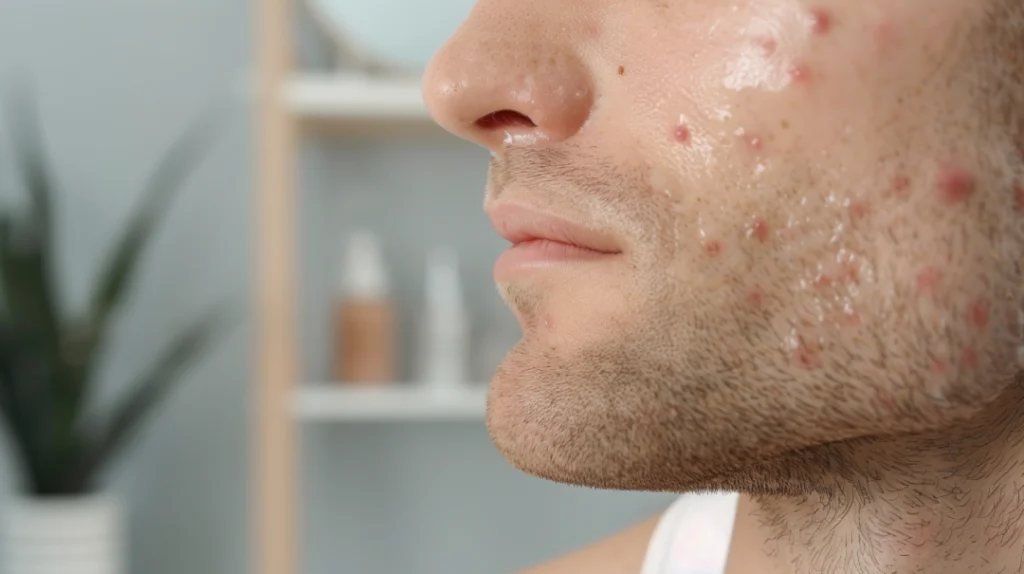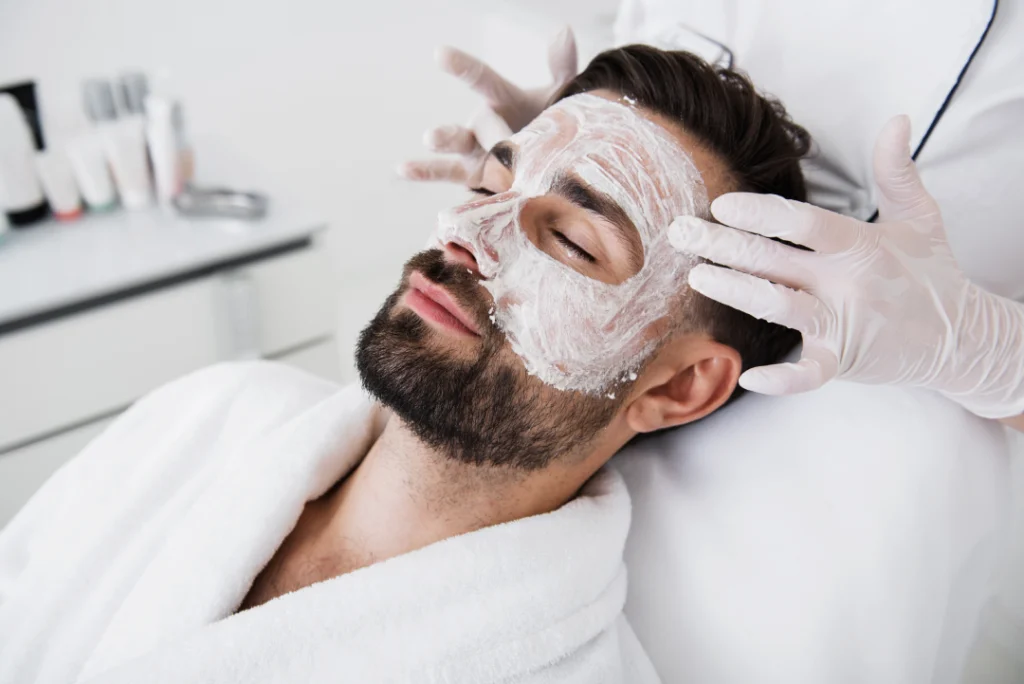Breakouts and irritation are two of the most frustrating skin issues for men, especially when they are tied to daily habits like shaving. Whether it is small bumps along your jawline or a full-blown breakout, the combination of razors, shaving cream, and sensitive skin can create the perfect storm for clogged pores and irritation.
But there is good news: modern acne treatments for men, like acne facials and targeted skin care regimens, can help you achieve clearer, smoother skin. With the right techniques and a few professional interventions, you can minimize shaving-related acne and irritation for good.
Keep reading to discover expert tips to keep your skin calm and breakout-free.
Why Shaving Can Cause Breakouts
Shaving is a daily ritual for many men, but it’s also a common culprit behind skin irritation and breakouts. While a clean-shaven look may exude confidence, the process of dragging a razor across your face can disrupt the delicate balance of your skin.
Here’s a closer look at why shaving can lead to pesky breakouts and irritation:
1. Clogged Pores from Hair and Skin Debris
Every time you shave, the razor not only cuts hair but also removes some of the top layer of skin. This exfoliation process can leave behind tiny pieces of hair and dead skin cells that settle into your pores.
Combine this with oil from your sebaceous glands and leftover shaving cream residue, and you’ve got a breeding ground for bacteria. Clogged pores are the first step in the development of acne, leading to blackheads, whiteheads, and inflamed pimples.
2. Razor Burn and Skin Trauma
Razor burn is a telltale sign that your skin isn’t happy with your shaving technique. Aggressive shaving, dull blades, or pressing too hard can scrape and irritate the skin. This microtrauma weakens the skin’s protective barrier, making it more susceptible to bacteria and environmental irritants. The result? Redness, tenderness, and a higher likelihood of breakouts.
3. Ingrown Hairs
Ingrown hairs are a major problem for men with coarse or curly hair. After shaving, cut hairs may curl back into the skin instead of growing outward. These ingrown hairs can trigger an inflammatory response, resulting in red, swollen bumps that often resemble acne.
Ingrown hairs are particularly common in areas like the neck and jawline, where the skin is more delicate and the hair grows at an angle.
4. Harsh Shaving Products
Many traditional shaving products contain ingredients that can irritate the skin or exacerbate acne-prone conditions.
- Alcohol-based aftershaves. While they may feel refreshing, these products strip the skin of moisture, leading to dryness and increased oil production as the skin tries to compensate.
- Fragrances and artificial additives. These can trigger sensitivity, especially for those with oily or acne-prone skin.
When the skin’s barrier is compromised by harsh products, it becomes more prone to inflammation and breakouts.
5. Bacterial Contamination from Razors
Your razor can harbor bacteria if not cleaned and stored properly. Every time you shave, you run the risk of transferring this bacteria onto your skin, which can lead to infection and acne. Additionally, using the same blade repeatedly increases the chance of bacterial growth, especially if the razor is left in a damp environment like the bathroom.
6. Overactive Sebaceous Glands
Shaving stimulates the skin, which can activate sebaceous glands to produce more oil. For men with oily skin, this increased sebum production can clog pores and create a perfect environment for acne-causing bacteria.
When paired with the physical disruption of shaving, this excess oil makes it even harder to keep skin clear and smooth.
7. Shaving Over Active Acne
Shaving over existing breakouts can aggravate the skin, spreading bacteria and worsening inflammation. Pimples are already fragile and prone to rupture, so dragging a razor across them increases the likelihood of spreading acne-causing bacteria to nearby pores.
Shaving over acne also makes healing more difficult, leaving the skin more vulnerable to scarring and postinflammatory hyperpigmentation.
8. Environmental and Lifestyle Factors
Shaving-related breakouts can be exacerbated by external factors, such as:
- Stress. Elevated stress levels can trigger hormonal imbalances, leading to more oil production and breakouts.
- Diet. High-glycemic foods, like sugary snacks and refined carbs, may increase inflammation and contribute to acne.
- Lack of hydration. Dehydrated skin becomes more sensitive and prone to irritation during shaving.

Effective Tips to Minimize Shaving Breakouts
Preventing breakouts from shaving isn’t just about technique—it is also about the products you use and how you care for your skin. Here are expert tips to help you achieve a smoother shave and clearer skin:
1. Prep Your Skin Before Shaving
Proper preparation is essential to prevent irritation and breakouts. Start by cleansing your face with a gentle, non-comedogenic cleanser to remove excess oil, dirt, and bacteria.
- Use warm water. Splashing your face with warm water opens up the pores and softens the hairs, making them easier to cut.
- Exfoliate gently. Use a mild exfoliant with acne-fighting ingredients like salicylic acid to remove dead skin cells and prevent clogged pores. This step is especially important if you have oily skin.
2. Choose the Right Razor
Not all razors are created equal, and the wrong one can wreak havoc on your skin.
- Use a sharp blade. Dull razors tug at the skin, increasing irritation and the likelihood of ingrown hairs. Replace your blade regularly to maintain a smooth, clean shave.
- Single-blade razors. For men prone to breakouts, a single-blade razor may reduce irritation compared to multi-blade options, which often cut hairs too short.
3. Shave in the Direction of Hair Growth
Shaving against the grain might give you a closer shave, but it also increases the risk of razor burn and ingrown hairs. Always shave in the direction of hair growth to minimize irritation.
- Short strokes. Use light, short strokes to avoid dragging the razor across your skin multiple times.
- Rinse frequently. Rinse your razor under warm water after each stroke to prevent buildup of hair and shaving cream.
4. Use a Hydrating Shaving Cream or Gel
A quality shaving cream or gel creates a protective barrier between your skin and the razor.
- Look for hydrating formulas. Choose products with soothing ingredients like aloe vera or glycerin to prevent dryness and irritation.
- Avoid alcohol-based products. These can dry out the skin and exacerbate inflammation.
5. Post-Shave Care Is Key
The moments after shaving are critical for preventing breakouts. Treat your skin with care:
- Rinse with cool water. This helps close the pores and reduce inflammation.
- Apply a soothing aftershave. Opt for alcohol-free, hydrating aftershaves with calming ingredients like chamomile or witch hazel.
- Moisturize. Use a lightweight, non-comedogenic moisturizer to lock in hydration without clogging pores.
6. Avoid Shaving Over Active Acne
Shaving over pimples can worsen inflammation and spread bacteria, leading to more breakouts. If you have active acne in certain areas, consider trimming the hair with clippers instead of using a razor.
- Spot-treat acne areas. Apply topical retinoids or salicylic acid to reduce inflammation and help treat acne before shaving.
7. Keep Your Tools Clean
Hygiene plays a big role in preventing breakouts. A dirty razor or unclean shaving brush can introduce bacteria to your skin, worsening irritation.
- Disinfect your razor. Rinse it with rubbing alcohol after each use.
- Store properly. Keep your razor in a clean, dry place to prevent bacterial growth.
8. Tailor Your Skincare Routine to Your Skin Type
Your skincare routine should complement your shaving habits and address your skin’s specific needs:
- For oily skin. Use a toner with acne-fighting ingredients like salicylic acid to control shine and keep pores clear.
- For sensitive skin. Stick to fragrance-free products with calming ingredients to prevent irritation.
- For acne-prone skin. Incorporate topical treatments like benzoyl peroxide or retinoids to target breakouts.
9. Invest in Professional Acne Treatments
When shaving-related acne and irritation persist despite your best efforts, it may be time to seek professional help. At Fitzy Shades MedSpa, we offer advanced acne treatments, including acne facials, to tackle stubborn breakouts and restore healthy skin.
- Acne Facials. These treatments deeply cleanse the skin, unclog pores and calm inflammation. By incorporating acne-fighting ingredients, our facials target the root causes of adult acne while soothing irritation caused by shaving.
- Customized Care. Our treatments are tailored to your unique skin type, ensuring optimal results for every individual.
Professional treatments are an excellent complement to your at-home skincare routine, providing an extra boost to keep your skin clear and irritation-free.

Clearer Skin Starts Here
At Fitzy Shades MedSpa in Prosper, TX, we understand the challenges of balancing shaving and skincare, especially when dealing with breakouts and irritation. Our expert team is here to help you achieve your best skin with tailored treatments, acne facials, and professional guidance.
Transform your routine and say goodbye to shaving-related breakouts with our proven solutions. Let’s work together to give your skin the care it deserves.
